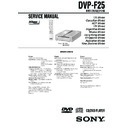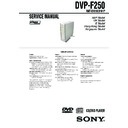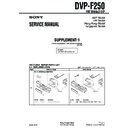Read Sony DVP-F25 Service Manual online
SERVICE MANUAL
CD/DVD PLAYER
SPECIFICATIONS
DVP-F25
RMT-D151A/D151E
US Model
Canadian Model
AEP Model
UK Model
Argentina Model
Mexico Model
Hong Kong Model
Singapore Model
Australian Model
New Zealand Model
Photo : DVP-F25
RMT-D151E
System
Laser: Semiconductor laser
Signal format system:
Signal format system:
:
PAL/NTSC
Audio characteristics
Frequency response: DVD VIDEO (PCM
96 kHz): 2 Hz to 44 kHz (
±1.0 dB)/DVD
VIDEO (PCM 48 kHz): 2 Hz to 22 kHz
(
(
±0.5 dB)/CD: 2 Hz to 20 kHz (±0.5 dB)
Signal-to-noise ratio (S/N ratio): 115 dB
(AUDIO OUT L/R jacks only)
Harmonic distortion: 0.003 %
Dynamic range: DVD VIDEO: 103 dB/CD:
Dynamic range: DVD VIDEO: 103 dB/CD:
99 dB
Wow and flutter: Less than detected value
(
±0.001% W PEAK)
When you play PCM sound tracks with a
96 kHz sampling frequency, the output
signals from the DIGITAL OUT (OPTICAL)
jack are converted to 48 kHz sampling
frequency.
96 kHz sampling frequency, the output
signals from the DIGITAL OUT (OPTICAL)
jack are converted to 48 kHz sampling
frequency.
Outputs
(Jack name: Jack type/Output level/Load
impedance)
AUDIO OUT L/R: Phono jack/2 Vrms/
10 kilohms
DIGITAL OUT (OPTICAL): Optical
output jack/-18 dBm (wave length:
660 nm)
660 nm)
COMPONENT VIDEO OUT (Y, C
B
, C
R
):
Phono jack/Y: 1.0 Vp-p/C
B
, C
R
:
0.7 Vp-p/75 ohms
VIDEO OUT: Phono jack/1.0 Vp-p/75 ohms
S VIDEO OUT: 4-pin mini DIN/
S VIDEO OUT: 4-pin mini DIN/
Y: 1.0 Vp-p/C: 0.3 Vp-p (PAL),
0.286 Vp-p (NTSC)/75 ohms
0.286 Vp-p (NTSC)/75 ohms
General
Power requirements:
2
US,Canadian,Mexico model:
120V AC, 60 Hz
Other country model:
120V AC, 60 Hz
Other country model:
20 to 240 V AC, 50/60 Hz
Power consumption: 9 W
Dimensions (approx.): 196
Dimensions (approx.): 196
× 61 × 265 mm
(wid
(7
3
/
4
× 2
1
/
2
× 10
1
/
2
in.)
th/height/depth) incl. projecting
parts
Mass (approx.): 1.8 kg (3 lb 14 oz.)
Operating temperature: 5
Operating temperature: 5
° C to 35 ° C
Operating humidity: 25 % to 80 %
Supplied accessories
See page 1-3.
Specifications and design are subject to
change without notice.
change without notice.
(except US/Canadian
model)
NTSC (US/Canadian
model)
model)
NTSC (US/Canadian
model)
(41
°F to 95 °F)
— 2 —
SAFETY-RELATED COMPONENT WARNING!!
COMPONENTS IDENTIFIED BY MARK 0 OR DOTTED LINE WITH
MARK 0 ON THE SCHEMATIC DIAGRAMS AND IN THE PARTS
LIST ARE CRITICAL TO SAFE OPERATION. REPLACE THESE
COMPONENTS WITH SONY PARTS WHOSE PART NUMBERS
APPEAR AS SHOWN IN THIS MANUAL OR IN SUPPLEMENTS
PUBLISHED BY SONY.
MARK 0 ON THE SCHEMATIC DIAGRAMS AND IN THE PARTS
LIST ARE CRITICAL TO SAFE OPERATION. REPLACE THESE
COMPONENTS WITH SONY PARTS WHOSE PART NUMBERS
APPEAR AS SHOWN IN THIS MANUAL OR IN SUPPLEMENTS
PUBLISHED BY SONY.
1.
Check the area of your repair for unsoldered or poorly-soldered
connections. Check the entire board surface for solder splashes
and bridges.
connections. Check the entire board surface for solder splashes
and bridges.
2.
Check the interboard wiring to ensure that no wires are
"pinched" or contact high-wattage resistors.
"pinched" or contact high-wattage resistors.
3.
Look for unauthorized replacement parts, particularly
transistors, that were installed during a previous repair. Point
them out to the customer and recommend their replacement.
transistors, that were installed during a previous repair. Point
them out to the customer and recommend their replacement.
4.
Look for parts which, through functioning, show obvious signs
of deterioration. Point them out to the customer and
recommend their replacement.
of deterioration. Point them out to the customer and
recommend their replacement.
5.
Check the B+ voltage to see it is at the values specified.
6.
Flexible Circuit Board Repairing
• Keep the temperature of the soldering iron around 270˚C
during repairing.
• Do not touch the soldering iron on the same conductor of the
circuit board (within 3 times).
• Be careful not to apply force on the conductor when soldering
or unsoldering.
SAFETY CHECK-OUT
After correcting the original service problem, perform the following
safety checks before releasing the set to the customer.
CAUTION
Use of controls or adjustments or performance of procedures
other than those specified herein may result in hazardous radiation
exposure.
Use of controls or adjustments or performance of procedures
other than those specified herein may result in hazardous radiation
exposure.
WARNING!!
WHEN SERVICING, DO NOT APPROACH THE LASER EXIT WITH
THE EYE TOO CLOSELY. IN CASE IT IS NECESSARY TO
CONFIRM LASER BEAM EMISSION, BE SURE TO OBSERVE
FROM A DISTANCE OF MORE THAN 25 cm FROM THE SURFACE
OF THE OBJECTIVE LENS ON THE OPTICAL PICK-UP BLOCK.
THE EYE TOO CLOSELY. IN CASE IT IS NECESSARY TO
CONFIRM LASER BEAM EMISSION, BE SURE TO OBSERVE
FROM A DISTANCE OF MORE THAN 25 cm FROM THE SURFACE
OF THE OBJECTIVE LENS ON THE OPTICAL PICK-UP BLOCK.
CAUTION:
The use of optical instrument with this product will increase eye
hazard.
The use of optical instrument with this product will increase eye
hazard.
Unleaded solder
Boards requiring use of unleaded solder are printed with the lead-
free mark (LF) indicating the solder contains no lead.
(Caution: Some printed circuit boards may not come printed with
the lead free mark due to their particular size.)
Boards requiring use of unleaded solder are printed with the lead-
free mark (LF) indicating the solder contains no lead.
(Caution: Some printed circuit boards may not come printed with
the lead free mark due to their particular size.)
: LEAD FREE MARK
Unleaded solder has the following characteristics.
• Unleaded solder melts at a temperature about 40°C higher than
• Unleaded solder melts at a temperature about 40°C higher than
ordinary solder.
Ordinary soldering irons can be used but the iron tip has to be
applied to the solder joint for a slightly longer time.
Soldering irons using a temperature regulator should be set to
about 350°C.
Caution: The printed pattern (copper foil) may peel away if the
heated tip is applied for too long, so be careful!
Ordinary soldering irons can be used but the iron tip has to be
applied to the solder joint for a slightly longer time.
Soldering irons using a temperature regulator should be set to
about 350°C.
Caution: The printed pattern (copper foil) may peel away if the
heated tip is applied for too long, so be careful!
• Strong viscosity
Unleaded solder is more viscous (sticky, less prone to flow) than
ordinary solder so use caution not to let solder bridges occur such
as on IC pins, etc.
ordinary solder so use caution not to let solder bridges occur such
as on IC pins, etc.
• Usable with ordinary solder
It is best to use only unleaded solder but unleaded solder may
also be added to ordinary solder.
also be added to ordinary solder.
— 3 —
TABLE OF CONTENTS
1.
GENERAL
Precautions ············································································· 1-1
About this Manual ································································· 1-1
This Player Can Play the Following Discs ···························· 1-1
Notes about the Discs ··························································· 1-2
Index to Parts and Controls ···················································· 1-2
Guide to On-Screen Displays (Control Bar) ·························· 1-3
About this Manual ································································· 1-1
This Player Can Play the Following Discs ···························· 1-1
Notes about the Discs ··························································· 1-2
Index to Parts and Controls ···················································· 1-2
Guide to On-Screen Displays (Control Bar) ·························· 1-3
Simple Start Guide ···································································· 1-3
Quick Overview ····································································· 1-3
Step 1: Unpacking ································································· 1-3
Step 2: Inserting Batteries into the Remote ··························· 1-3
Step 3: TV Hookups ······························································ 1-3
Step 4: Playing a Disc ···························································· 1-4
Step 1: Unpacking ································································· 1-3
Step 2: Inserting Batteries into the Remote ··························· 1-3
Step 3: TV Hookups ······························································ 1-3
Step 4: Playing a Disc ···························································· 1-4
Hookups ····················································································· 1-4
Hooking Up the Player ·························································· 1-4
Step 1: Connecting the Video Cords ······································ 1-4
Step 2: Connecting the Audio Cords ····································· 1-5
Step 3: Attaching the Jack Cover and Stand ·························· 1-6
Step 4: Connecting the Power Cord ······································· 1-7
Step 5: Quick Setup ······························································· 1-7
Step 1: Connecting the Video Cords ······································ 1-4
Step 2: Connecting the Audio Cords ····································· 1-5
Step 3: Attaching the Jack Cover and Stand ·························· 1-6
Step 4: Connecting the Power Cord ······································· 1-7
Step 5: Quick Setup ······························································· 1-7
Playing Discs ············································································· 1-7
Playing Discs ········································································· 1-7
Searching for a Particular Point on a Disc
(Scan, Slow-motion Play) ··················································· 1-8
Resuming Playback from the Point Where You Stopped the
Disc (Multi-disc Resume) ··················································· 1-8
Using the DVD’s Menu. ························································ 1-8
Playing VIDEO CDs with PBC Functions (PBC Playback) ·· 1-9
Playing an MP3 Audio Track ················································· 1-9
Various Play Mode Functions (Programme Play, Shuffle Play,
Repeat Play, A-B Repeat Play) ··········································· 1-9
Searching for a Particular Point on a Disc
(Scan, Slow-motion Play) ··················································· 1-8
Resuming Playback from the Point Where You Stopped the
Disc (Multi-disc Resume) ··················································· 1-8
Using the DVD’s Menu. ························································ 1-8
Playing VIDEO CDs with PBC Functions (PBC Playback) ·· 1-9
Playing an MP3 Audio Track ················································· 1-9
Various Play Mode Functions (Programme Play, Shuffle Play,
Repeat Play, A-B Repeat Play) ··········································· 1-9
Searching for a Scene ······························································ 1-11
Searching for a Title/Chapter/Track/Index/Scene
(Search mode) ··································································· 1-11
(Search mode) ··································································· 1-11
Viewing Information About the Disc ······································· 1-11
Checking the Playing Time and Remaining Time ··············· 1-11
Sound Adjustments ·································································· 1-12
Changing the Sound ····························································· 1-12
TV Virtual Surround Settings (TVS) ··································· 1-12
TV Virtual Surround Settings (TVS) ··································· 1-12
Enjoying Movies ····································································· 1-12
Changing the Angles ···························································· 1-12
Displaying the Subtitles ······················································· 1-12
Adjusting the Picture Quality (BNR) ·································· 1-13
Adjusting the Playback Picture
(CUSTOM PICTURE MODE) ········································· 1-13
Enhancing the Playback Picture (DIGITAL VIDEO
ENHANCER) ··································································· 1-13
Displaying the Subtitles ······················································· 1-12
Adjusting the Picture Quality (BNR) ·································· 1-13
Adjusting the Playback Picture
(CUSTOM PICTURE MODE) ········································· 1-13
Enhancing the Playback Picture (DIGITAL VIDEO
ENHANCER) ··································································· 1-13
Using Various Additional Functions ········································ 1-14
Locking Discs (CUSTOM PARENTAL CONTROL,
PARENTAL CONTROL) ················································· 1-14
Controlling Your TV with the Supplied Remote ················· 1-15
PARENTAL CONTROL) ················································· 1-14
Controlling Your TV with the Supplied Remote ················· 1-15
Settings and Adjustments ························································ 1-15
Using the Setup Display ······················································ 1-15
Setting the Display or Sound Track Language
(LANGUAGE SETUP) ···················································· 1-15
Settings for the Display (SCREEN SETUP) ······················· 1-16
Custom Settings (CUSTOM SETUP) ································· 1-16
Settings for the Sound (AUDIO SETUP) ···························· 1-16
Setting the Display or Sound Track Language
(LANGUAGE SETUP) ···················································· 1-15
Settings for the Display (SCREEN SETUP) ······················· 1-16
Custom Settings (CUSTOM SETUP) ································· 1-16
Settings for the Sound (AUDIO SETUP) ···························· 1-16
Additional Information ···························································· 1-17
Troubleshooting ··································································· 1-17
Self-diagnosis Function (When letters/numbers appear in the
display) ············································································· 1-17
Glossary ··············································································· 1-18
Language Code List ····························································· 1-18
Self-diagnosis Function (When letters/numbers appear in the
display) ············································································· 1-17
Glossary ··············································································· 1-18
Language Code List ····························································· 1-18
2.
DISASSEMBLY
2-1.
UPPER CASE ASSEMBLY ············································ 2-2
2-2.
LOWER CASE ································································ 2-2
2-3.
CONTROL PANEL ASSEMBLY ··································· 2-2
2-4.
COVER ············································································ 2-2
2-5.
SW-377 BOARD, IF-96 BOARD ··································· 2-3
2-6.
MECHANISM DECK ····················································· 2-3
2-7.
CHUCKING ARM BLOCK ··········································· 2-3
2-8.
MD-90 BOARD, LEVER ASSEMBLY ·························· 2-3
2-9.
BASE (C) ASSEMBLY ··················································· 2-4
2-10. OPTICAL DEVICE ························································ 2-4
2-11. BU HOLDER, RACK (L) ··············································· 2-4
2-12. GATE ASSEMBLY, COVER (C) ···································· 2-4
2-13. ROLLER (SLIDER) ························································ 2-5
2-14. SLIDER (L), SLIDER (R) ··············································· 2-5
2-15. IR-42 BOARD ································································· 2-5
2-16. POWER BLOCK ····························································· 2-5
2-17. MB-106 BOARD ····························································· 2-6
2-18. AV-68 BOARD ································································ 2-6
2-19. SLIDERS (L) AND (R) PHASE ADJUSTMENT ·········· 2-6
2-20. INTERNAL VIEWS ························································ 2-7
2-21. CIRCUIT BOARDS LOCATION ··································· 2-8
2-11. BU HOLDER, RACK (L) ··············································· 2-4
2-12. GATE ASSEMBLY, COVER (C) ···································· 2-4
2-13. ROLLER (SLIDER) ························································ 2-5
2-14. SLIDER (L), SLIDER (R) ··············································· 2-5
2-15. IR-42 BOARD ································································· 2-5
2-16. POWER BLOCK ····························································· 2-5
2-17. MB-106 BOARD ····························································· 2-6
2-18. AV-68 BOARD ································································ 2-6
2-19. SLIDERS (L) AND (R) PHASE ADJUSTMENT ·········· 2-6
2-20. INTERNAL VIEWS ························································ 2-7
2-21. CIRCUIT BOARDS LOCATION ··································· 2-8
3.
BLOCK DIAGRAMS
3-1.
OVERALL BLOCK DIAGRAM ···································· 3-1
3-2.
RF/SERVO BLOCK DIAGRAM ···································· 3-3
3-3.
SIGNAL PROCESSOR BLOCK DIAGRAM ················ 3-5
3-4.
SYSTEM CONTROL BLOCK DIAGRAM ··················· 3-7
3-5.
VIDEO BLOCK DIAGRAM ·········································· 3-9
3-6.
AUDIO BLOCK DIAGRAM ········································ 3-11
3-7.
INTERFACE CONTROL BLOCK DIAGRAM ··········· 3-13
3-8.
POWER BLOCK DIAGRAM (1/2) ······························ 3-15
3-9.
POWER BLOCK DIAGRAM (2/2) ······························ 3-17
4.
PRINTED WIRING BOARDS AND
SCHEMATIC DIAGRAMS
SCHEMATIC DIAGRAMS
4-1.
FRAME SCHEMATIC DIAGRAM ································ 4-1
4-2.
PRINTED WIRING BOARDS AND
SCHEMATIC DIAGRAM ·············································· 4-4
SCHEMATIC DIAGRAM ·············································· 4-4
• MB-106 (DVD/CD, RF AMP, DIGITAL SERVO,
MOTOR DRIVE, SERVO, AV DECODER, SD RAM,
SYSTEM CONTROL, AUDIO ADC, PLL, POWER,
INTERFACE CONTROL)
SYSTEM CONTROL, AUDIO ADC, PLL, POWER,
INTERFACE CONTROL)
PRINTED WIRING BOARD ························· 4-7
• MB-106 (DVD/CD, RF AMP, DIGITAL SERVO) (1/8)
SCHEMATIC DIAGRAM ···························· 4-11
• MB-106 (MOTOR DRIVE) (2/8)
SCHEMATIC DIAGRAM ···························· 4-13
• MB-106 (SERVO) (3/8)
SCHEMATIC DIAGRAM ···························· 4-15
• MB-106 (AV DECODER) (4/8)
SCHEMATIC DIAGRAM ···························· 4-17
• MB-106 (SD RAM) (5/8)
SCHEMATIC DIAGRAM ···························· 4-19
• MB-106 (SYSTEM CONTROL) (6/8)
SCHEMATIC DIAGRAM ···························· 4-21
• MB-106 (INTERFACE CONTROL) (7/8), IR-42 (IR),
SW-377 (FUNCTION KEY), IF-96 (FRONT KEY)
SCHEMATIC DIAGRAMS ·························· 4-23
• MB-106 (POWER, AUDIO ADC, PLL) (8/8)
SCHEMATIC DIAGRAM ···························· 4-25
• AV-68 (AV OUT)
PRINTED WIRING BOARD ······················· 4-27
• AV-68 (AV OUT)
SCHEMATIC DIAGRAM ···························· 4-29
• MD-89 (FUNCTION SWITCH 1),
MD-90 (FUNCTION SWITCH), MD-91 (SWITCH)
PRINTED WIRING BOARDS ····················· 4-31
• MD-89 (FUNCTION SWITCH 1),
MD-90 (FUNCTION SWITCH), MD-91 (SWITCH)
SCHEMATIC DIAGRAM ···························· 4-33
— 4 —
• POWER BLOCK (ZSSR216GA/ZSSR216HA)
PRINTED WIRING BOARD ······················· 4-35
• POWER BLOCK (ZSSR216GA/ZSSR216HA)
SCHEMATIC DIAGRAM ···························· 4-37
• IR-42 (IR), SW-377 (FUNCTION KEY),
IF-96 (FRONT KEY)
PRINTED WIRING BOARDS ····················· 4-39
5.
IC PIN FUNCTION DESCRIPTION
5-1.
SYSTEM CONTROL PIN FUNCTION
(MB-106 BOARD IC104: MB91307RPFV-G-BND-E1) · 5-1
(MB-106 BOARD IC104: MB91307RPFV-G-BND-E1) · 5-1
6.
TEST MODE
6-1.
GENERAL DESCRIPTION ··········································· 6-1
6-2.
STARTING TEST MODE ··············································· 6-1
6-3.
SYSCON DIAGNOSIS ··················································· 6-1
6-4.
DRIVE AUTO ADJUSTMENT ······································ 6-5
6-5.
DRIVE MANUAL OPERATION ··································· 6-7
6-6.
MECHA AGING ··························································· 6-11
6-7.
EMERGENCY HISTORY ············································ 6-11
6-8.
VERSION INFORMATION ········································· 6-11
6-9.
VIDEO LEVEL ADJUSTMENT ·································· 6-11
6-10. IF CON SELF DIAGNOSTIC FUNCTION ················· 6-12
7.
ELECTRICAL ADJUSTMENT
7-1.
POWER SUPPLY CHECK ············································· 7-1
7-2.
ADJUSTMENT OF VIDEO SYSTEM ··························· 7-2
7-3.
ADJUSTMENT RELATED PARTS ARRANGEMENT ·· 7-4
8.
REPAIR PARTS LIST
8-1.
EXPLODED VIEWS ······················································ 8-1
8-1-1. OVERALL SECTION ····················································· 8-2
8-1-2. MECHANISM DECK SECTION-1 ······························· 8-3
8-1-3. MECHANISM DECK SECTION-2 ······························· 8-4
8-1-4. MAIN CHASSIS SECTION ··········································· 8-5
8-2.
8-1-2. MECHANISM DECK SECTION-1 ······························· 8-3
8-1-3. MECHANISM DECK SECTION-2 ······························· 8-4
8-1-4. MAIN CHASSIS SECTION ··········································· 8-5
8-2.
ELECTRICAL PARTS LIST ·········································· 8-6



